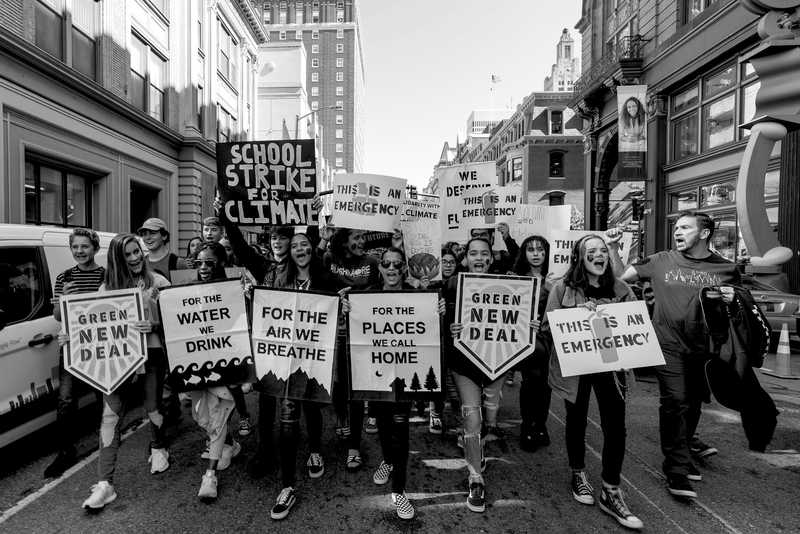The World People’s Conference on Climate Change and the Rights of Mother Earth. The People’s Summit at Rio+20. The People’s Climate March. The People’s Climate Movement. The last decade has seen a renewal of climate justice activism, defined less by urgency than an anti-establishment political rhetoric largely absent from mainstream environmentalisms of the recent past.
Given its emphasis on grassroots people power and an unstinting critique of global elites and corporations, we should view some portions of contemporary climate justice movement as participating in a left-populist genre of political rhetoric and mobilization. This orientation has culminated in transnational movements for a Green New Deal from 2018 to the present. An optimistic reading of the situation would suggest such movements never been closer to a global political transformation aligned with principles of climate justice: a prioritization of frontline communities, workers, and the poor. A cynic might point out the complete lack of concrete political action corresponding to these supposed shifts in rhetoric and strategy. Regardless of one’s proclivity, it behooves us to look back and make a sober balance sheet of the last ten years. What have been the consequences of the left-populist orientation of climate justice politics? What strategic lessons can we draw from this movement’s successes and failures?
A Brief History of Climate Populism
Climate populism markedly differs from the technocratic and policy-oriented approaches to climate change of the recent past. Non-profit environmentalist strategy of the 1990s and early 2000s had adapted itself well to the political norms of Third Way neoliberalism. This orientation emphasized building pragmatic alliances across ruling class institutions in order to reach consensus on sustainable development priorities. Consider the annual UNFCCC meeting, which brings together “diverse” actors like Bill Gates, Alec Baldwin, and Al Gore along with state leaders and big-ticket NGOs to hash out the details of nonbinding, incrementalist, and largely market-driven agreements. The emphasis on reaching consensus and adhering to scientific and technical-driven tools and goals meant that politics – understood as antagonistic disagreement – was actively marginalized in the mainstream. A spatial example of this marginalizations could be seen at every annual Council of Parties meeting, where the climate justice movement was confined to a zone outside the official meeting space.
The oppositional climate justice strategy began to change after the disappointing results of the COP15 Copenhagen Accord in 2009, which entailed an exodus from the official international climate towards parallel spaces of coalition building like the 2010 World People’s Conference on Climate Change and the Rights of Mother Earth in Cochabamba, Bolivia. Tadzio Mueller has argued that even this space was constrained by internal splits within the Latin American populist left concerning extractivism and Indigenous rights. At the time, Mueller also noted that “In the North, from where this article is written, many climate (justice) activists have had to face up to the problem that political frames centered around climate change struggle to generate a mass base.”
Along with other young climate justice organizers in the United States, I too felt an impasse at this time. With the concurrent failure of the 2009 Waxman-Markey bill and increasing signs that the Obama administration did not represent the progressive break many of us had hoped, climate justice activists began to reconsider how they might build such a “mass base.” We gave up on policy, instead attempting to build better relationships with and among grassroots communities on the “frontlines” of extraction and climate chaos. These movements were led by Indigenous nations, migrant farmworkers, Black liberationists, coastal fisherpeople, farmers and ranchers, and industrial union workers rather than nonprofits (even environmental justice ones!). While climate change might be a component of their analyses of coal fired power plants, hydrofracking fields, and tar sands pipelines, more often they emerged from people’s everyday struggles for clean water and air in what Marxist-feminists call the realm of “social reproduction.” What made these movements somewhat different from their predecessors in the prior decades of environmental justice struggles was a desire or need to coordinate and share strategies across difference and distance in order to build a “bigger we”. Drawing on the afterlives of the US agrarian populist tradition, the easy-to-access rhetoric of US-American democracy, the language of the global decolonial and Black power movements, and a new “multiracial populism,” the frequent name for that collective was “the people.”
What Counts as a Populist Movement?
Surveying the last five years of liberal commentary might give one the impression that “populism” is a synonym for the anti-democratic political right. This move is itself a strategic attempt to simultaneously equate and discredit all threats to liberal centrism. Traditional leftist critiques of populism (and “the people” as a subject) have also tended to focus on the problem of ethnonationalism. Isn’t “the people” just a codeword for white supremacy counterposed to some racially-coded corrupting foreign outsider? There’s no sense in denying the existence of right-populist movements and their use of the rhetoric of “the people” in this fashion. Yet more capacious constructions of “the people” are possible. The climate justice movement, for example, tends to take “the people” to be a global subject rather than a national project (though some accept the constraints of the nation-state a bit too readily). The Latin American leftist understanding of “el pueblo” also resists the ethnonationalist reduction, formed as it is by reference to a constituent power of the people that exceeds that of the state.
Nonetheless, the left-populist project of constructing a subject is not without problems. An opposite concern than the ethnonationalist one is that “the people” might be too broad a subject, including almost everyone and making it difficult to distinguish comrades from mere allies, and either from political enemies. This can certainly be a concern, as when nationalists and green capitalists attempt to influence people’s movements. Populist demands can become too diluted, losing their orientation to a specific political vision (such as ecosocialism) or strategy (such as movement building). Yet even if there are some grey areas and disagreements among the climate justice movement, there are pretty clear bad guys which most of us recognize: fossil fuel corporations, green colonists, perhaps capitalism more generally.
We can see the widespread and quick uptake of the Green New Deal (GND) as an outcome of the success of the populist orientation. Though versions of a GND had floated around the liberal policy world for some time, it wasn’t until savvy youth groups like the Sunrise Movement made a GND part of their platform that the vision rocketed back on the scene. Today, such plans have tended to be less radical than they purport to be – often appearing as a version of “life support Keynesianism.” Nonetheless, its current popularity among wide swaths of the environmental arena and the left alike represents a massive shift from the limp demands of the earlier cycle of climate politics. As Matthew Miles Goodrich has argued, this represents a shift in which “Perhaps paradoxically, a political approach to fighting climate change has, in a moment of political crisis, become a source of hope.” Crucial to this new politicized approach is the fact that it is borne by a different political subject – the masses, the frontlines, common people – who would presumably not merely demand change from institutionalized others, but actually wield power to accomplish the GND vision.
It’s absolutely crucial that the climate justice movement has transformed from an “an apolitical movement for refusing to engage with the basic mechanisms of power,” to borrow Goodrich’s words again. But that doesn’t help us adjudicate whether the agonistic left-populist political strategy is the best one. And while there are plenty of sympathetic (and many less sympathetic) critiques of the Green New Deal floating around, most have focused on the content of the demand, rather than the subject who would accomplish it.
The Subject of Climate Populism
Demands and subjects are, of course, linked: subjects don’t simply pre-exist their articulation in political movements, but are reshaped by them. Demands create subjects, subjects incomplete and torn in different directions. Liberal demands both rely on and reproduce liberal subjects: free individuals, consumers, private property owners. Socialist or anti-imperialist demands produce socialist or anti-imperialist subjects: subjects seeking solidarity and comradeship in the name of justice. Environmentalist demands create environmental subjects. Populist demands create subjects oriented to the popular. What, then, are the limits of the vague subject of “the people” created in the new climate justice movement?
First, while climate populism might have rendered the GND “popular” in some manner, it is clear that even for the vast majority of supporters, this popularity is thin. No amount of supportive polling data can stand in for the concrete actions of a mass movement. Consequently, much like the US populism of the 1890s or Jesse Jackson’s 1980s attempts to build a Rainbow Coalition, climate populism today imagines its small actual coalition to portend a much larger coalition than actually exists. One consequence of thin popularity is that our aspirational rhetoric does not match our experiences. This can create anxiety within the movement and suspicion of self-critique concerning strategy – especially after a premature move from the streets to the ballot box. After failures, instead of self-critique we have confusion: Weren’t we supposed to be popular? If self-critique is displaced on to others, then lessons are not learned. Further, if only thinly popular, any speculative GND is likely to preclude the key details that a justice- or socialist-oriented GND might put at the center. Unconditional transnational aid via the climate justice fund? Health care and free movement for all? Indigenous veto rights on clean energy projects? Who or what will be on the chopping block first? Consequently, it seems that the subject of climate populism understands politics, but not yet political power. Climate populism creates subjects attached to a fantasy of mass mobilization, but without the actual movement to leverage it.
Second, the orientation towards an imagined “popular mass” can serve as a throttle on more radical and transgressive elements of such movements. I found that the populist orientation of some anti-pipeline organizations led them to actively oppose anarchists and Indigenous adherents of direct-action, who were understood to be threatening to the supposed “family-friendly” popularity that the movement sought. On the interior, the movement is encouraged to orient itself to a lowest-common-denominator subject with an assumed unchangeable set of interests in actually-existing consumption-based society. This allows space for particularly perverse understandings of climate politics to play out. Imagining and building a radically transformed social world is disallowed, because regular people would never willingly give up the emotional fulfillment of “sneakers, Lego sets, waffle-irons, and yes flat-screen TVs and X-boxes.” Climate populism thus creates subjects who are trying to be popular. This creates similar problems to that of “normie socialism.” Kate Doyle Griffiths writes that at a cultural level, the injunction towards normalcy belies a lack of confidence and reinforces an unstated orientation towards white EuroAmerican heteronormativity, while at the political level, it suggests “an assertion of electoral politics, and specifically those within the Democratic Party, as the horizon of the socialist movement.” In short, the subject of climate populism allows its imagination to be constrained by what it believes generic normal people are like.
Third and finally, there is a problem connecting to the various geographies of the popular or mass base of climate populism. If this is indeed to be a movement for planetary justice, the material world of the global proletariat must be at the heart of the (class) struggle. However, despite frequent overtures to the Global South and class-based workers’ struggle, too often the populist end of the current climate justice movement often speaks mostly in the name of those masses. The “darker nations” still appear in the discourse of climate populism as simply the huddled victims of climate chaos, frequently rendered into the figure of the migrant or refugee. So too are visions of a North American GND unevenly shaped based on region, landscape, and history. While critiques of global capitalism and colonialism are increasingly centralized, due in no small part to the transnational leadership of Indigenous nations, in other arenas climate populism has not fared as well. How many of us are certain that a GND means, for example, for open borders, cancellation of global debts, and a transnational anti-militarism and anti-imperialism? A related problem is the suggestion that the GND would be enacted by a dubious “cross-class” subject. Any alliance with capital, or even the middle class in the US, is unlikely to produce a successful transformation towards climate justice. The subject of climate populism thus imagines itself to be more capacious than it is, because it represents rather than builds itself within the global proletariat.
The best adherents of the GND point towards not an historic or contemporary set of policies associated with the “New Deal,” but instead the mass struggle that forced their passage. The problem isn’t simply that the New Deal had certain unintended racial effects (which we can now correct), but that the Deal was itself a capitulation and capture of the more radical agitation of the moment. And yet this radical agitation is precisely denounced by denizens of left populism. If mass agitation and struggle is to be in our minds, the subjects we create must be more transformative than “the people” allows; this means holding out space for organizations – councils, cadres, and mutual aid orgs –not frequently associated with popular mobilization.
What is to be done?
This analysis is not a call to return to a position where we “enjoy our marginalization,” which some of the Left is more than happy to do. Instead, it is a matter of being realistic about the power the climate justice movement is currently capable of flexing, and what arenas that power can actually become efficacious. In North America, it seems that the power of the GND coalition is, disappointingly, largely confined to the same spheres as the earlier cycle: nonprofits, self-defined activists, a smattering of directly-affected peoples.
In many ways, the injunction towards social distancing due to the COVID-19 crisis makes political organizing right now more difficult than ever before. However, this interregnum can be useful for re-evaluation of the recent past and preparation for what appears to be a uniquely ripe planetary economic crisis, one that is deeply material rather than merely rhetorical. It is likely that the short and medium term will yield food, fuel, and circulation crises, almost certainly experienced unevenly due to the neocolonial global division of labor.
In a world of deep economic crisis, is the Green New Deal merely an atavism of life support Keynesianism, a zombie grasp for something, anything – a People’s Bailout? – to renew economic growth? Or can a new, popular movement emerge materially from within this moment of crisis?




